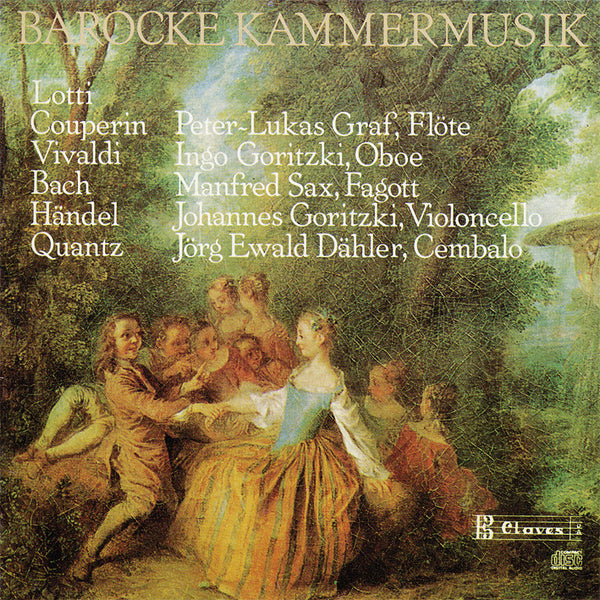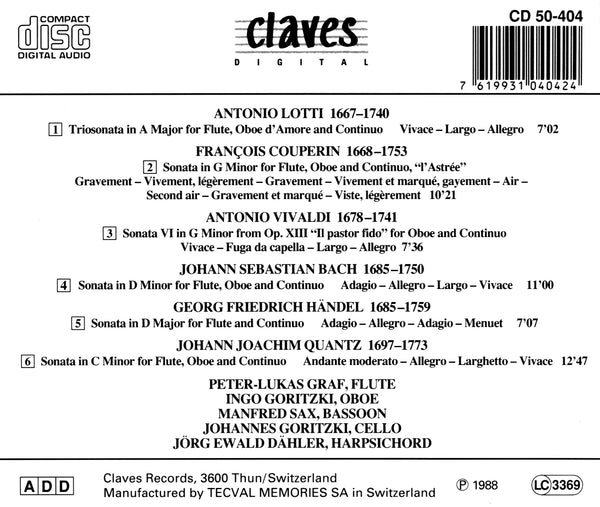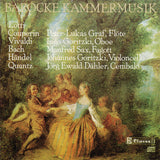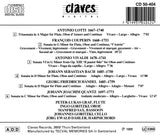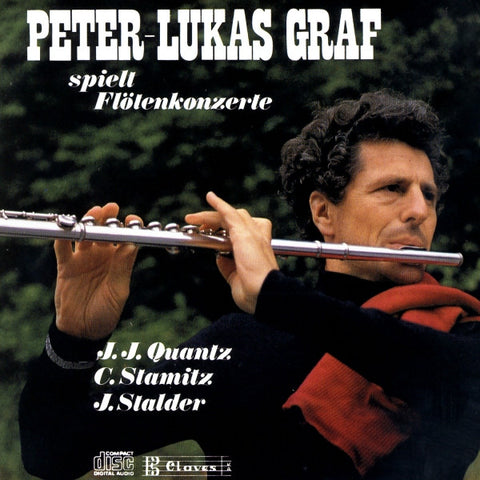(1988) Barocke Kammermusik
Category(ies): Ancient music
Instrument(s): Bassoon Cello Flute Harpischord Oboe
Main Composer: Various composers (see collections)
Main Composer: Antonio Vivaldi
CD set: 1
Catalog N°:
CD 0404
Release: 1987
EAN/UPC: 7619931040424
- UPC: 829410626965
This album is now on repressing. Pre-order it at a special price now.
CHF 18.50
This album is no longer available on CD.
This album has not been released yet. Pre-order it from now.
CHF 18.50
This album is no longer available on CD.
This album is no longer available on CD.
VAT included for Switzerland & UE
Free shipping
This album is now on repressing. Pre-order it at a special price now.
CHF 18.50
This album is no longer available on CD.
This album has not been released yet.
Pre-order it at a special price now.
CHF 18.50
This album is no longer available on CD.
This album is no longer available on CD.
BAROCKE KAMMERMUSIK
The Trio for German flute, oboe d’amore and thorough-bass by Antonio Lotti, according to another source, was also published as a G. Ph. Telemann composition. Where style is concerned the question of who the true composer was cannot be settled. The embellishments of the outside movements seem to be characteristic of Telemann, while there can be no doubt that the simple vocal central movement is more like Lotti. The work being composed in three movements, the first movement, a quick one, seems to point to the fact that Lotti was the composer; the single outward difference (of a technical nature) between the two versions, also points to Lotti as being the composer: The G major key of Telemann’s version is played as B flat major on the oboe d’amore, whereas Lotti’s A major is played as C major – a version more convenient to the imperfect baroque instruments.
The trio sonata ‘L’Astrée’ by François Couperin is an early work of the great French master. It is quite possible that the Italian influence on the young Couperin is expressed in the significant slow movements. On the whole, however, the work bears the stamp of the general 18th century French style of embellishment, primarily expressed in the grace notes such as the trill, mordent, appoggiatura, double notes, slurs and other similar forms of embellishments’ (H. O. Schmitz).
Antonio Vivaldi’s Opus XIII, first printed in 1737, is appropriately entitled ‘Il pastor fido’ (the faithful shepherd), since it contains a collection of sonatas for various instruments of mostly bucolic character: bagpipe, hurdy-gurdy, flute, oboe (among them the g minor sonata on the present recording) and violin. In Vivaldi’s large oeuvre the oboe is not nearly as important as the violin; also the number of sonatas is relatively small considering Vivaldi’s output of concertos. It is thus not surprising that few sonatas for oboe are extant. Like the majority of his compositions they were written for his pupils at the ‘Ospedale della Pietà’, an orphanage in Venice, famous for its concerts under Vivaldi’s direction.
Entitled ‘Trio ex Db a Violino et Clavecin obligé di Mons. Bach’ the sonata recorded here is contained in a manuscript volume of the first half of the 18th century. According to the practice of the time, the composition was published by M. Seiffert and H. Keller in the version for two violins and thorough-bass. But, no less important is the attempt undertaken here to entrust the soprano voices with the two most important wind instruments of the time, namely, the German flute and the oboe. Much doubt has been cast upon the work as being an authentic composition of Johann Sebastian Bach. In many parts, however, the material used is so much like Bach (cp. the beginning of the second movement) that the composer must at least be looked for amongst J. S. Bach’s most intimate circle of pupils. An alternative – possible are Friedemann Bach or J. L. Krebs as composers – has not yet been proved.
The authenticity of the sonata for flute in D major by Georg Friedrich Händel is also doubted. Handed down in a separate transcript it could well belong to the group of the so-called ‘Hallenser-Sonaten’, written by the youthful Händel during his stay at the university of Halle (Germany). The unpretentious melodic quality of this sonata has a special charm. On the present recording the harpsichord is supported by a bassoon, which accentuates the two-part writing of the composition.
In 1717, Mattheson referred to the Italian style as ‘sharp, colorful and expressive’, as opposed to the French style which he termed as ‘natural, flowing, tender’. Johann Joachim Quantz, who pursued his goal to combine these two styles to form a so-called German style, used the French simplicity of structure and the new Italian possibilities of expression without giving up his newly formed German style. The trio sonata can be considered a good example of this mixture of styles. The frequent use of dissonant effects is remarkable – particularly in the slow movements – which meets with one of quantz’ basic requirements, for ‘without this mixture of harmony and discord, music would be deprived of a means to instantly arouse and quieten a variety of passions’ (Quantz). Moreover, the instrumentation of this sonata is of particular interest, as Quantz composed it for the two instruments with which he was most familiar. We must bear in mind that the oboe was his main instrument before he became the famous flutist, and it was n his capacity as oboist that, in 1718, he received his first appointment to August II’s Polish Royal Oerchestra.
(1988) Barocke Kammermusik - CD 0404
The Trio for German flute, oboe d’amore and thorough-bass by Antonio Lotti, according to another source, was also published as a G. Ph. Telemann composition. Where style is concerned the question of who the true composer was cannot be settled. The embellishments of the outside movements seem to be characteristic of Telemann, while there can be no doubt that the simple vocal central movement is more like Lotti. The work being composed in three movements, the first movement, a quick one, seems to point to the fact that Lotti was the composer; the single outward difference (of a technical nature) between the two versions, also points to Lotti as being the composer: The G major key of Telemann’s version is played as B flat major on the oboe d’amore, whereas Lotti’s A major is played as C major – a version more convenient to the imperfect baroque instruments.
The trio sonata ‘L’Astrée’ by François Couperin is an early work of the great French master. It is quite possible that the Italian influence on the young Couperin is expressed in the significant slow movements. On the whole, however, the work bears the stamp of the general 18th century French style of embellishment, primarily expressed in the grace notes such as the trill, mordent, appoggiatura, double notes, slurs and other similar forms of embellishments’ (H. O. Schmitz).
Antonio Vivaldi’s Opus XIII, first printed in 1737, is appropriately entitled ‘Il pastor fido’ (the faithful shepherd), since it contains a collection of sonatas for various instruments of mostly bucolic character: bagpipe, hurdy-gurdy, flute, oboe (among them the g minor sonata on the present recording) and violin. In Vivaldi’s large oeuvre the oboe is not nearly as important as the violin; also the number of sonatas is relatively small considering Vivaldi’s output of concertos. It is thus not surprising that few sonatas for oboe are extant. Like the majority of his compositions they were written for his pupils at the ‘Ospedale della Pietà’, an orphanage in Venice, famous for its concerts under Vivaldi’s direction.
Entitled ‘Trio ex Db a Violino et Clavecin obligé di Mons. Bach’ the sonata recorded here is contained in a manuscript volume of the first half of the 18th century. According to the practice of the time, the composition was published by M. Seiffert and H. Keller in the version for two violins and thorough-bass. But, no less important is the attempt undertaken here to entrust the soprano voices with the two most important wind instruments of the time, namely, the German flute and the oboe. Much doubt has been cast upon the work as being an authentic composition of Johann Sebastian Bach. In many parts, however, the material used is so much like Bach (cp. the beginning of the second movement) that the composer must at least be looked for amongst J. S. Bach’s most intimate circle of pupils. An alternative – possible are Friedemann Bach or J. L. Krebs as composers – has not yet been proved.
The authenticity of the sonata for flute in D major by Georg Friedrich Händel is also doubted. Handed down in a separate transcript it could well belong to the group of the so-called ‘Hallenser-Sonaten’, written by the youthful Händel during his stay at the university of Halle (Germany). The unpretentious melodic quality of this sonata has a special charm. On the present recording the harpsichord is supported by a bassoon, which accentuates the two-part writing of the composition.
In 1717, Mattheson referred to the Italian style as ‘sharp, colorful and expressive’, as opposed to the French style which he termed as ‘natural, flowing, tender’. Johann Joachim Quantz, who pursued his goal to combine these two styles to form a so-called German style, used the French simplicity of structure and the new Italian possibilities of expression without giving up his newly formed German style. The trio sonata can be considered a good example of this mixture of styles. The frequent use of dissonant effects is remarkable – particularly in the slow movements – which meets with one of quantz’ basic requirements, for ‘without this mixture of harmony and discord, music would be deprived of a means to instantly arouse and quieten a variety of passions’ (Quantz). Moreover, the instrumentation of this sonata is of particular interest, as Quantz composed it for the two instruments with which he was most familiar. We must bear in mind that the oboe was his main instrument before he became the famous flutist, and it was n his capacity as oboist that, in 1718, he received his first appointment to August II’s Polish Royal Oerchestra.
Return to the album | Read the booklet | Composer(s): Various composers | Composer(s): Antonio Vivaldi | Main Artist: Peter-Lukas Graf













